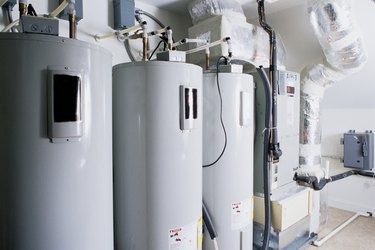
Boiler furnaces burn a fuel, such as natural gas or heating oil, to turn water into steam. The steam pressure forces it throughout a building's heating system, where it warms the air via radiators. Boilers can develop cracks due to the steam pressure or other factors, which require quick action to address safely.
Shutting Down
Video of the Day
When a boiler furnace is cracked, the possibility exists for a fuel leak or explosion. This means that the first procedure upon noticing a crack, besides contacting a repair professional or emergency personnel if there are already injuries, involves shutting down the boiler. Fuel valves restrict the flow of gas or oil into the boiler, while pressure release valves reduce the pressure inside the boiler to safe levels. Only someone with the proper training should attempt to shut down the boiler.
Video of the Day
Waiting
Boilers become extremely hot during use. This means that once a cracked boiler is shut off, you should wait before handling or attempting to repair the boiler. Even surfaces that aren't directly exposed to heat may be hot enough to burn your skin if they are in close proximity to heated surfaces. Use the time while you wait for the boiler to cool to check for additional visible cracks, or to clean up fuel and water leaks in the boiler room.
Diagnosing
Once a boiler is cool enough to touch, you can diagnose the source of the crack. Cracked tubes and fuel lines may be a result of corrosion, rust and age. In other cases, a faulty pressure valve will allow too much pressure to build up, causing the boiler to rupture. Rust and physical breakage are the most obvious signs of damage, though the nature of the crack may require a repair professional to diagnose the problem for less obvious causes.
Repair or Replacement
Depending on the source of a boiler crack, replacing specific components may be a possible solution. Faulty valves and cracked tubes are relatively simple to replace. Cracks in a boiler's tank are more complicated, however. They require welding so that the tank can withstand the pressure of normal operation. In some cases it may be necessary to replace the tank, which usually means replacing the entire boiler assembly.